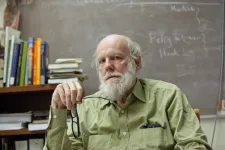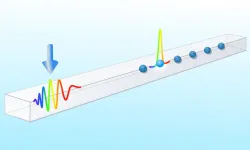(Press-News.org) A new model of aging takes into account not only genetics and environmental exposures but also the tiny changes that randomly arise at the cellular level.
University Professor Caleb Finch introduced the "Tripartite Phenotype of Aging" as a new conceptual model that addresses why lifespan varies so much, even among human identical twins who share the same genes. Only about 10 to 35 percent of longevity can be traced to genes inherited from our parents, Finch mentioned.
Finch authored the paper introducing the model with one of his former graduate students, Amin Haghani, who received his PhD in the Biology of Aging from the USC Leonard Davis School in 2020 and is now a postdoctoral researcher at UCLA. In the article, they propose that the limited heritability of aging patterns and longevity in humans is an outcome of gene-environment interactions, together with stochastic, or chance, variations in the body's cells. These random changes can include cellular changes that happen during development, molecular damage that occurs later in life, and more.
"We wanted to introduce a conceptual map and some new terminology that will motivate a more comprehensive understanding of what the limitations of genetic determinants in aging are, how important it is to consider the genetic variance in relationship to the environment, and include this new domain of stochastic variations, which is very well recognized by different fields," said Finch, who holds the ARCO/William F. Kieschnick Chair in the Neurobiology of Aging at the USC Leonard Davis School. "It hasn’t really been put in a formal context in which the complete package can be discussed, and that’s what I hope our article achieves."
Expanding on the exposome
The new model is a natural extension of the idea of the exposome, which was first proposed by cancer epidemiologist Christopher Paul Wild in 2005 to draw attention to the need for more data on lifetime exposure to environmental carcinogens. The exposome concept illustrates how external factors, ranging from air pollution and socioeconomic status to individual diet and exercise patterns, interact with endogenous, or internal, factors such as the body's microbiome and fat deposits.
The exposome is now a mainstream model, eclipsing previous characterizations of environmental factors as affecting risk "one by one." Finch has previously expanded on the exposome concept with the introduction of the Alzheimer's disease exposome. The gero-exposome now considers how genes and the environment interact over the lifespan to shape how we age.
The new model illustrates that cell-by-cell variations in gene expression, variations arising during development, random mutations, and epigenetic changes - turning genes "off" or "on" - should be explicitly considered apart from traditional genetic or environmental research regarding aging, Finch said. More detailed study into these chance processes has been enabled by cutting-edge research techniques, including the study of gene transcription within single cells as well as ChIP-sequencing, which can illustrate how individual proteins interact with DNA.
Effects of happenstance on health
In the paper, Finch and Haghani discussed several examples of how risks of age-related disease are poorly predicted by DNA alone but are heavily influenced by environmental exposures as well as the time and duration of the exposure, including during development or over the course of decades.
One well-known example of a gene that is associated with increased Alzheimer's risk is ApoE-4; however, having the ApoE-4 gene doesn't definitively mean someone will get Alzheimer's. Studies in both mice and humans revealed that ApoE-4 and clusters of related genes interact with exposures such as air pollution or cigarette smoke to influence risk, and Alzheimer's patients also show differences in their epigenetics as compared to individuals without the disease.
He added that the idea of environmental exposure can stretch farther than many people expect. Disease exposure earlier in life can affect health risks later in life - and across generations.
"The environment that we’re exposed to goes back to our grandmothers because the egg we came from was in our mother’s ovaries at the time of her birth," he explained. "So that means, in my case, because my grandmother was born in 1878, I might very well carry some traces of the 19th century environment, which included much greater exposure to infectious disease because there were no antibiotics."
Finch said that he hopes the more comprehensive model on how genes, environment, and random variations over time interact to influence aging prompt a new discussion of what the rapidly developing field of precision medicine needs to take into account to promote healthy aging.
"I think that there will be a much greater recognition in understanding individual patterns of aging," he said. "We can only define it up to a certain point by knowing the genetic risks; we must have a more comprehensive understanding of the lifetime exposures, environments and lifestyles of an individual to have a better understanding of genetic risk for particular diseases."
INFORMATION:
"Gene-Environment interactions and stochastic variations in the Gero-Exposome" was published online in the Journals of Gerontology, Series A in February 2021. The research was supported by National Institutes of Health grants R01-AG051521, P50-AG005142, and P01-AG055367 to Finch and training support to Haghani via T32- AG052374.
Researchers at Lund University in Sweden can now show that a new examination method identifies high-risk plaques in the blood vessels surrounding the heart, that cannot be seen solely with traditional angiograms. This type of plaque, rich in fat, could potentially cause recurring heart attacks in patients with heart disease. The study is published in the The Lancet.
"We have been working on this study for ten years. This creates a unique opportunity to treat plaques before they cause a heart attack", says David Erlinge, professor of cardiology at Lund University and Consultant in ...
During 1995-2015, fullerene derivatives had been the dominating electron acceptors in organic solar cells (OSCs) owing to their performance superior to other acceptors. However, the drawbacks of fullerenes, such as weak visible absorption, limited tunability of electronic properties and morphological instability, restrict further development of OSCs toward higher efficiencies and practical applications. Therefore, the development of new acceptors beyond fullerenes is urgent in the field of OSCs.
Professor Zhan Xiaowei from the College of Engineering at Peking University is one of the pioneers engaging in development of nonfullerene acceptors in the world. ...
University of Otago researchers have discovered one of the reasons why more than 50 per cent of people with type 2 diabetes die from heart disease.
And perhaps more significantly, they have found how to treat it.
Associate Professor Rajesh Katare, of the Department of Physiology, says it has been known that stem cells in the heart of diabetic patients are impaired. While stem cell therapy has proved effective in treating heart disease, it is not the case in diabetic hearts.
It has not been known why; until now.
It comes down to tiny molecules called microRNA which control gene expression.
"Based on the results of laboratory testing, ...
New bioarchaeological research shows malaria has threatened human communities for more than 7000 years, earlier than when the onset of farming was thought to have sparked its devastating arrival.
Lead author Dr Melandri Vlok from the Department of Anatomy, University of Otago, says this ground-breaking research, published today in Scientific Reports, changes the entire understanding of the relationship humans have had with malaria, still one of the deadliest diseases in the world.
"Until now we've believed malaria became a global threat to humans when we turned to farming, but our research shows in at least Southeast Asia this disease was a threat to human groups well before that.
"This research providing a new cornerstone of malaria's evolution with humans is a great achievement ...
When people think of sea level rise, they usually think of coastal erosion. However, recent computer modeling studies indicate that coastal wastewater infrastructure, which includes sewer lines and cesspools, is likely to flood with groundwater as sea-level rises.
A new study, published by University of Hawai'i (UH) at Mānoa earth scientists, is the first to provide direct evidence that tidally-driven groundwater inundation of wastewater infrastructure is occurring today in urban Honolulu, Hawai'i. The study shows that higher ocean water levels ...
Light-emitting diodes (LEDs) have revolutionized the displays industry. LEDs use electric current to produce visible light without the excess heat found in traditional light bulbs, a glow called electroluminescence. This breakthrough led to the eye-popping, high-definition viewing experience we've come to expect from our screens. Now, a group of physicists and chemists have developed a new type of LED that utilizes spintronics without needing a magnetic field, magnetic materials or cryogenic temperatures; a "quantum leap" that could take displays to the next level.
"The companies that make LEDs or TV and computer displays don't want to deal with magnetic fields and magnetic materials. It's heavy ...
TOKYO - Toshiba Corporation (TOKYO: 6502), the industry leader in solutions for large-scale optimization problems, today announced a scale-out technology that minimizes hardware limitations, an evolution of its optimization computer, the Simulation Bifurcation Machine (SBM), that supports continued increases in computing speed and scale. Toshiba expects the new SBM to be a game changer for real-world problems that require large-scale, high-speed and low-latency, such as simultaneous financial transactions involving large numbers of stock, and complex control of multiple robots. The research results were published in Nature Electronics*1 on March 1.
Speed and scale are keys to success in industrial sectors ...
Waste cooking oil, sulfur and wool offcuts have been put to good use by green chemists at Flinders University to produce a sustainable new kind of housing insulation material.
The latest environmentally friendly building product from experts at the Flinders Chalker Lab and colleagues at Deakin and Liverpool University, has been described in a new paper published in Chemistry Europe ahead of Global Recycling Day (18 March 2021)
The insulating composite was made from the sustainable building blocks of wool fires, sulfur, and canola oil to produce a promising new model for next-generation insulation - not only capitalising on wool's natural low flammability but also to make significant energy savings for property owners and tenants.
The new composite is one of several exciting ...
Magnetic reconnection refers to the reconfiguration of magnetic field geometry. It plays an elemental role in the rapid release of magnetic energy and its conversion to other forms of energy in magnetized plasma systems throughout the universe.
Researchers led by Dr. LI Leping from the National Astronomical Observatories of the Chinese Academy of Sciences (NAOC) analyzed the evolution of magnetic reconnection and its nearby filament. The result suggested that reconnection is significantly accelerated by the propagating disturbance caused by the adjacent filament eruption.
The study was published in The Astrophysical Journal on Feb. 25.
The New Vacuum Solar Telescope (NVST) is a ...
In order to exploit the properties of quantum physics technologically, quantum objects and their interaction must be precisely controlled. In many cases, this is done using light. Researchers at the University of Innsbruck and the Institute of Quantum Optics and Quantum Information (IQOQI) of the Austrian Academy of Sciences have now developed a method to individually address quantum emitters using tailored light pulses. "Not only is it important to individually control and read the state of the emitters," says Oriol Romero-Isart, "but also to do so while leaving the system as undisturbed as possible." Together with Juan Jose? Garci?a-Ripoll (IQOQI visiting fellow) from the Instituto de Fi?sica Fundamental in Madrid, Romero-Isart's research group has ...







